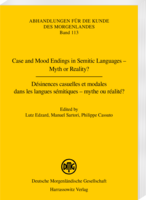|
|
more titles of the subject:
Download:
Please note: With adding digital Products to your cart
the payment will be handled via PayPal. The download will be provided after the payment is confirmed. In the context of Arabic and Semitic, it is only natural to treat case and mood under one umbrella: Arab grammarians ingenuously devised the same terms for the independent case and the independent mood on the one hand, and for the dependent case and the dependent mood, respectively. Still, the main focus of these proceedings lies on case in Semitic and Afroasiatic, wherever relevant. Thereby, taking up controversial data, issues, arguments and discussion is indispensable.
The volume contains contributions covering data mainly from Akkadian, Hebrew, Arabic, Ethio-Semitic, Berber, and selected Cushitic and Omotic languages. One paper investigates the diachronic development of case and the mimation in Akkadian, another discusses a number of accepted as well as a number of controversial residues of case in Biblical Hebrew and proposes suggestions of reanalysis in this context. A critical reading of chapter 17 of al-Zaǧǧāǧī’s ʾĪḍāḥ is offered as well as a summary and further development of recent discussion on the scenario of case in historical varieties of Arabic. The discussion about “The Case for Proto-Semitic and Proto-Arabic Case” is followed up. Furthermore, the intricacies of delimitating the concepts of case and state in Berber are discussed as well as the meaningfulness of applying the opposition “nominative” vs. “absolutive”, which is widely acknowledged to be valid in a broader Afroasiatic perspective, to Semitic. The final paper rounds up the volume with some more general deliberations on the verbal system in Semitic, thereby proposing a four-stage model. |
|||||||||||||||||||||||||||||||||||||||






